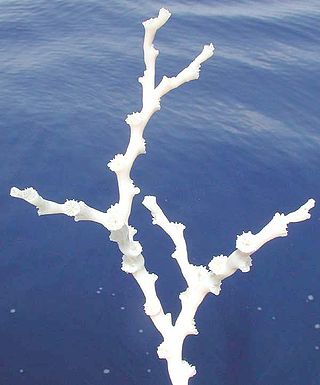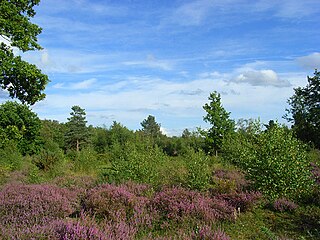
Lophelia pertusa, the only species in the genus Lophelia, is a cold-water coral that grows in the deep waters throughout the North Atlantic ocean, as well as parts of the Caribbean Sea and Alboran Sea. Although L. pertusa reefs are home to a diverse community, the species is extremely slow growing and may be harmed by destructive fishing practices, or oil exploration and extraction.

Green laver, known as aonori in Japan, sea cabbage (海白菜) or hutai (滸苔) in China, and parae (파래) in Korean, is a type of edible green seaweed, including species from the genera Monostroma and Ulva. It is commercially cultivated in some bay areas in Japan, Korea, and Taiwan, such as Ise Bay. It is rich in minerals such as calcium, magnesium, lithium, vitamins, and amino acids such as methionine. It is also called aosa in some places in Japan.

Pertusa is a municipality located in the province of Huesca, Aragon, Spain.

The habitat of deep-water corals, also known as cold-water corals, extends to deeper, darker parts of the oceans than tropical corals, ranging from near the surface to the abyss, beyond 2,000 metres (6,600 ft) where water temperatures may be as cold as 4 °C (39 °F). Deep-water corals belong to the Phylum Cnidaria and are most often stony corals, but also include black and thorny corals and soft corals including the Gorgonians. Like tropical corals, they provide habitat to other species, but deep-water corals do not require zooxanthellae to survive.

Snelsmore Common is a 104-hectare (260-acre) biological Site of Special Scientific Interest north of Newbury in Berkshire. It is owned by West Berkshire Council and managed by the Berkshire, Buckinghamshire and Oxfordshire Wildlife Trust.

The Pertusariales are an order of fungi in the class Lecanoromycetes. It contains the following families: Coccotremataceae, Icmadophilaceae, Megasporaceae, Microcaliciaceae, Ochrolechiaceae, Pertusariaceae, Varicellariaceae, and Variolariaceae. Many of these fungi form lichens.

The Pertusariaceae are a family of lichen-forming fungi in the order Pertusariales.

Pertusaria is a large genus of warty crustose lichens in the Pertusariaceae family. The fruiting bodies are usually modified apothecia that immersed in warts on the main body (thallus) with small holes for the spores to emerge, similar to ostioles, or are fully above and lecanorine (spore bearing discs surrounded by a ring of tissue similar to the tissue of the thallus. Members of the genus are commonly called wart lichens.

Bothriochloa pertusa is a species of grass. It is widely used as a fodder and a graze for livestock.

Porta Pertusa is one of the gates of the Leonine Wall in Rome (Italy).
Alan W. Archer is a mycologist and taxonomist. He is currently an honorary research associate at Royal Botanic Gardens Sydney. He uses chemotaxonomy as well as morphological features in taxonomy and to devise keys, most recently for the genus Pertusaria in the Australasia region.
Alejandro Manzanera Pertusa is a Spanish tennis player.

Glyphis cicatricosa is a crustose lichen in the family Graphidaceae. It has a pantropical distribution, being found in the US, Central and South America, South, South-East and East Asia, Australia, New Zealand and the Pacific.
Pertusaria sipmanii is a species of crustose lichen in the family Pertusariaceae. Found in Papua New Guinea, it was formally described as a new species in 1998 by Alan Archer and John Elix. The species epithet sipmanii honours Dutch lichenologist Harrie Sipman, who collected the type specimen.
Lepra schaereri is a species of crustose lichen in the family Pertusariaceae. It occurs in Europe. It was first described by Swiss pastor and lichenologist Ludwig Schaerer in 1821 as Spiloma isidioides. Josef Hafellner renamed it as Pertusaria schaereri in 2001, and then transferred it to Lepra after that genus was reinstated in 2016 to contain members of the Pertusaria albescens species group.
Sebastian Gorzny and Alex Michelsen defeated Gabriel Debru and Paul Inchauspé in the final, 7–6(7–5), 6–3 to win the boys' doubles tennis title at the 2022 Wimbledon Championships.
Pseudopyrenidium is a genus of lichenicolous (lichen-dwelling) fungi in the family Adelococcaceae. The genus was circumscribed in 2010 by Père Navarro-Rosinés, Mikhail Zhurbenko, and Claude Roux. It has two species:











